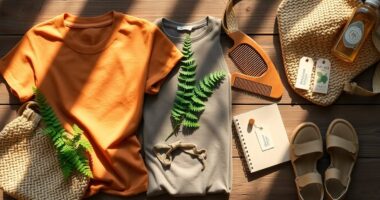The rise of slow fashion in 2025 matters because it’s reshaping how you think about clothing and sustainability. With 80% of shoppers willing to pay more for eco-friendly products, you’re part of a movement emphasizing quality over quantity. Fast fashion’s harmful effects on the environment are leading many to support ethical brands and secondhand markets. By prioritizing these choices, you contribute to a healthier planet. Discover how this trend can impact your wardrobe for the better.
Key Takeaways
- The slow fashion movement emphasizes sustainability, with 80% of shoppers willing to pay more for eco-friendly products in 2025.
- Increased awareness of fast fashion’s environmental impact drives consumers towards sustainable alternatives and timeless clothing investments.
- The secondhand clothing market is surging, benefiting local communities and promoting ethical fashion practices.
- Social media plays a crucial role in influencing sustainable shopping habits and raising awareness of the environmental consequences of clothing purchases.
- Collaboration between brands and suppliers fosters a sustainable fashion ecosystem, minimizing carbon emissions and encouraging responsible consumption.

As you step into the world of fashion in 2025, you’ll notice a remarkable shift towards slow fashion—a movement that’s gaining momentum as consumers increasingly prioritize sustainability. This trend isn’t just a passing phase; around 80% of shoppers are now willing to pay more for sustainable products. This growing demand reflects a significant change in consumer behavior, driven by increased awareness of the environmental impacts of fast fashion, such as pollution and waste.
Fast fashion’s detrimental effects on the environment have pushed the industry to adapt. With climate targets and sustainability regulations coming into play, businesses must incorporate eco-friendly practices to remain competitive. You’ll find that many brands are leaning towards innovative materials and circular economy solutions, like recycling and repurposing, to reduce waste and their overall carbon footprint.
This shift isn’t just good for the planet; it can also bolster the economy. The secondhand and pre-owned clothing market is projected to surge, offering you sustainable alternatives while also benefiting local communities. Additionally, the rise of ethical fashion trends indicates that consumers are increasingly making fashion choices that reflect their values.
As you navigate this evolving landscape, you’ll notice the expanding secondhand markets that provide a viable option for those looking to shop sustainably. Supporting local brands can further reduce the environmental impact associated with fast fashion, allowing you to make more informed purchasing decisions. The emphasis on quality over quantity means you’ll be encouraged to invest in timeless pieces that stand the test of time, reducing the frequency of your purchases.
Social media plays a pivotal role in this transformation. Platforms are buzzing with trends that promote vintage fashion and sustainable choices, influencing your shopping habits. As you become more aware of the environmental consequences of your clothing purchases, you’re likely to prioritize sustainability when making decisions.
In 2025, you’ll find that the collaboration between brands and suppliers is essential in minimizing carbon emissions, creating a more sustainable fashion ecosystem. The rise of collaborative consumption—sharing or renting clothing—provides yet another alternative to traditional fashion consumption.
This growing focus on sustainability reshapes the industry, fostering an environment where ethical practices thrive. Ultimately, as you embrace slow fashion, you’ll not only contribute to a healthier planet but also redefine your personal style in a way that aligns with your values. This movement is more than just a trend; it’s a significant shift towards a more responsible and conscious approach to fashion.
Frequently Asked Questions
How Can I Identify Slow Fashion Brands?
To identify slow fashion brands, look for certifications like GOTS or Fair Trade Certified.
Check if they’re transparent about their sourcing and production processes.
Focus on brands that prioritize quality over quantity, producing smaller batches with durable materials.
Research their material choices, opting for biodegradable options like organic cotton or hemp.
Finally, educate yourself on sustainability ratings from platforms like Good On You to guarantee you’re making informed choices.
What Are the Environmental Benefits of Slow Fashion?
Imagine walking through a lush forest, where every step you take nurtures the earth.
That’s what slow fashion does for our planet. It cuts down on waste and pollution, using fewer resources to create fewer garments. You’ll save water, reduce carbon footprints, and support healthier ecosystems.
Is Slow Fashion More Expensive Than Fast Fashion?
Yes, slow fashion is generally more expensive than fast fashion. You’ll notice that the initial costs of quality, durable items often exceed those of cheaper, trendy fast fashion pieces.
However, consider this: slow fashion can save you money in the long run. With fewer replacements needed, you might actually spend less overall.
Plus, investing in sustainable clothing supports ethical practices and reduces environmental impact, making it a worthwhile choice for both your wallet and the planet.
How Can I Transition My Wardrobe to Slow Fashion?
To shift your wardrobe to slow fashion, start by evaluating your current pieces. Invest in high-quality, timeless items that you’ll wear for years.
Choose eco-friendly materials and support ethical brands that prioritize craftsmanship. Consider thrifting or swapping clothes to minimize waste.
Build a versatile capsule wardrobe that reflects your personal style, reducing the urge to follow fleeting trends.
Finally, focus on mindful consumption; buy less but invest in pieces that truly matter.
What Role Does Consumer Education Play in Slow Fashion?
When it comes to slow fashion, knowledge is power. Consumer education plays a pivotal role by helping you understand sustainable practices and the impact of your choices.
The more you know, the better decisions you can make—like choosing high-quality, eco-friendly garments.
By prioritizing brands committed to sustainability, you not only support a healthier planet but also influence the industry to adopt more responsible practices.
It’s a win-win for you and the environment!
Conclusion
As you embrace the slow fashion movement in 2025, you’re not just making sustainable choices; you’re joining a growing community that values quality over quantity. Imagine supporting a local brand that produces handmade, timeless pieces, like a beautifully crafted jacket that lasts for years. By investing in such items, you’re reducing waste and promoting ethical practices. Together, you can shift the industry towards a healthier future, where style and sustainability walk hand in hand.










